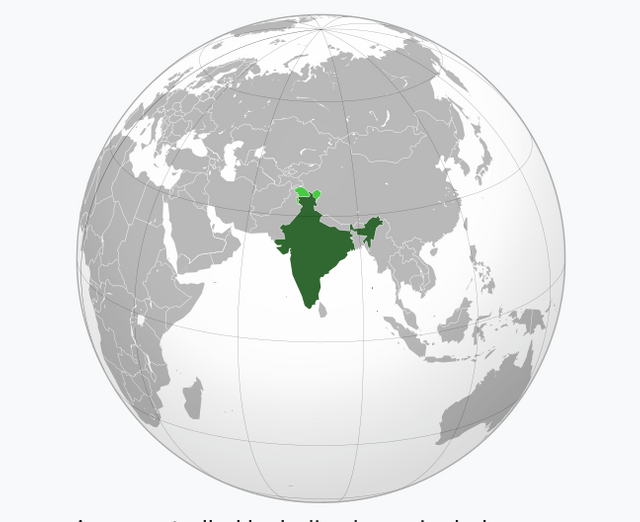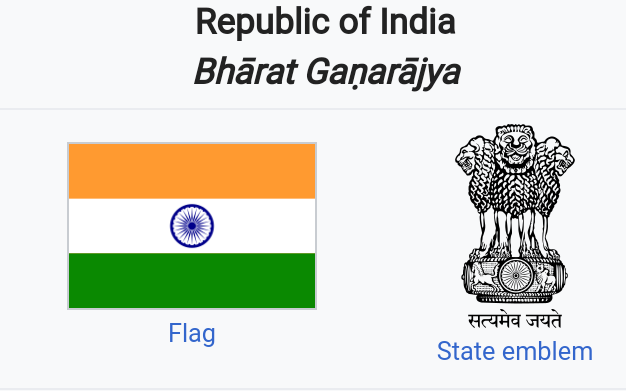India is a vast South Asian country with diverse terrain – from Himalayan peaks to Indian Ocean coastline – and history reaching back 5 millennia. In the north, Mughal Empire landmarks include Delhi’s Red Fort complex and massive Jama Masjid mosque, plus Agra’s iconic Taj Mahal mausoleum. Pilgrims bathe in the Ganges in Varanasi, and Rishikesh is a yoga centre and base for Himalayan trekking.

India (IAST: Bhārat), also called the Republic of India (IAST: Bhārat Gaṇarājya),[19][e] is a country in South Asia. It is the seventh-largest country by area, the second-most populous country (with over 1.2 billion people), and the most populous democracy in the world. It is bounded by the Indian Ocean on the south, the Arabian Sea on the southwest, and the Bay of Bengal on the southeast. It shares land borders with Pakistan to the west;[f] China, Nepal, and Bhutan to the northeast; and Bangladesh and Myanmar to the east. In the Indian Ocean, India is in the vicinity of Sri Lanka and the Maldives. India's Andaman and Nicobar Islands share a maritime border with Thailand and Indonesia
Capital
New Delhi
28°36′50″N 77°12′30″E
Largest city
Mumbai
18°58′30″N 72°49′40″E
Official languages
HindiEnglish[b][6]
Recognised regional languages
State level and
Eighth Schedule[7]
AssameseBengaliBodoDogriGujaratiKannadaKashmiriKokborokKonkaniMaithiliMalayalamManipuriMarathiMizoNepaliOdiaPunjabiSanskritSantaliSindhiTamilTeluguUrdu
National language
None[8][9][10]
Religion
79.8% Hinduism
14.2% Islam
2.3% Christianity
1.7% Sikhism
0.7% Buddhism
0.4% Jainism
0.9% others[c][11]
Demonym
Indian
Membership
United Nations, World Trade Organisation, BRICS, South Asian Association for Regional Cooperation, Shanghai Cooperation Organisation, G8+5, G20, Commonwealth of Nations
Government
Federal parliamentary
constitutional socialist[12]
republic[1]
• President
Ram Nath Kovind
• Vice President
Venkaiah Naidu
• Prime Minister
Narendra Modi
• Chief Justice
Dipak Misra
• Speaker of the Lok Sabha
Sumitra Mahajan
Legislature
Parliament
• Upper house
Rajya Sabha
• Lower house
Lok Sabha
Independence from the United Kingdom
• Dominion
15 August 1947
• Republic
26 January 1950
Area
• Total
3,287,263[5] km2 (1,269,219 sq mi)[d] (7th)
• Water (%)
9.6
Population
• 2016 estimate
1,324,171,354[13] (2nd)
• 2011 census
1,210,854,977[14][15] (2nd)
• Density
397.9/km2 (1,030.6/sq mi) (31st)
GDP (PPP)
2018 estimate
• Total
$10.385 trillion[16] (3rd)
• Per capita
$7,783[16] (116th)
GDP (nominal)
2018 estimate
• Total
$2.848 trillion[16] (6th)
• Per capita
$2,134[16] (133rd)
Gini (2013)
33.9[17]
medium · 79th
HDI (2015)
Increase 0.624[18]
medium · 131st
Currency
Indian rupee (₹) (INR)
Time zone
IST (UTC+05:30)
DST is not observed
Date format
dd-mm-yyyy
Drives on the
left
Calling code
+91
ISO 3166 code
IN
Internet TLD
.in
The Indian subcontinent was home to the urban Indus Valley Civilisation of the 3rd millennium BCE. In the following millennium, the oldest scriptures associated with Hinduism began to be composed. Social stratification, based on caste, emerged in the first millennium BCE, and Buddhism and Jainism arose. Early political consolidations took place under the Maurya and Gupta empires; the later peninsular Middle Kingdoms influenced cultures as far as southeast Asia. In the medieval era, Judaism, Zoroastrianism, Christianity, and Islam arrived, and Sikhism emerged, all adding to the region's diverse culture. Much of the north fell to the Delhi sultanate; the south was united under the Vijayanagara Empire. The economy expanded in the 17th century in the Mughal Empire. In the mid-18th century, the subcontinent came under British East India Company rule, and in the mid-19th under British crown rule. A nationalist movement emerged in the late 19th century, which later, under Mahatma Gandhi, was noted for nonviolent resistance and led to India's independence in 1947.
In 2017, the Indian economy was the world's sixth largest by nominal GDP[20] and third largest by purchasing power parity.[16] Following market-based economic reforms in 1991, India became one of the fastest-growing major economies and is considered a newly industrialised country. However, it continues to face the challenges of poverty, corruption, malnutrition, and inadequate public healthcare. A nuclear weapons state and regional power, it has the second largest standing army in the world and ranks fifth in military expenditure among nations. India is a federal republic governed under a parliamentary system and consists of 29 states and 7 union territories. It is a pluralistic, multilingual and multi-ethnic society and is also home to a diversity of wildlife in a variety of protected habitats.

Source
Plagiarism is the copying & pasting of others work without giving credit to the original author or artist. Plagiarized posts are considered spam.
Spam is discouraged by the community, and may result in action from the cheetah bot.
More information and tips on sharing content.
If you believe this comment is in error, please contact us in #disputes on Discord
Downvoting a post can decrease pending rewards and make it less visible. Common reasons:
Submit
Hi! I am a robot. I just upvoted you! I found similar content that readers might be interested in:
https://en.wikipedia.org/wiki/India_Portal
Downvoting a post can decrease pending rewards and make it less visible. Common reasons:
Submit